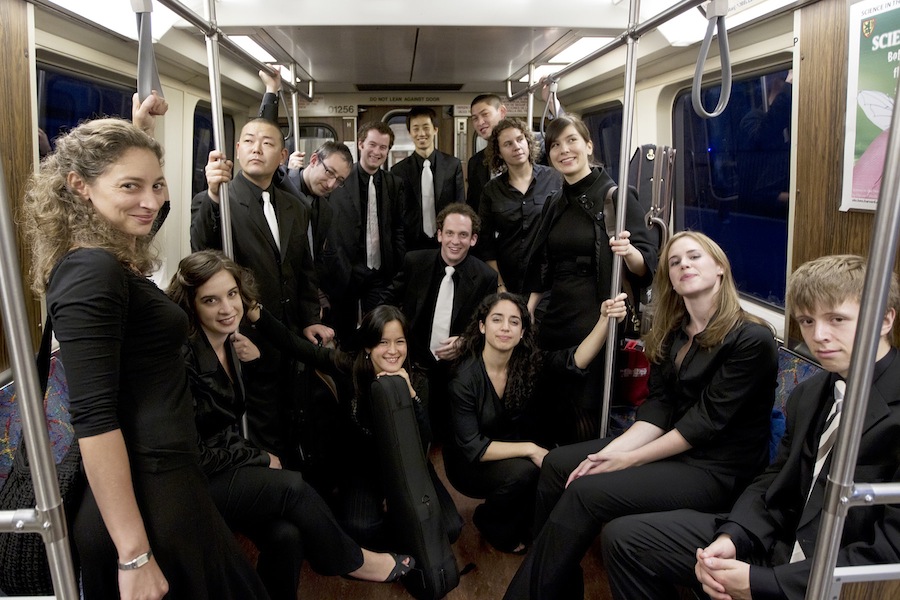From Gesualdo to Liu, A Far Cry serves up a typically venturesome evening at the Gardner Museum
“Kill that scoundrel along with this harlot! Shall a Gesualdo be made a cuckold?”
With these words, according to one version of the story, the composer and Prince of Venosa plunged a dagger into the bodies of his wife, Maria D’Avalos, and her lover, the Duke of Andria.
At the Gardner Museum Thursday night, A Far Cry, the museum’s conductorless resident orchestra, explored Gesualdo’s story in a performance of Brett Dean’s Carlo for strings and tape as part of a wide-ranging and experimental program.
Carlo opens with a recorded performance–played on a sampler–of the opening from Gesualdo’s most famous madrigal, Moro lasso. When the strings entered with pizzicato and light bowed phrases to answer the meandering chromatic lines of the madrigal, one easily sensed the similarities between Gesualdo’s style and much contemporary avant-garde music. As the strings built the madrigal fragments to a climax, the sampler, played by Ethan Wood, provides eerie vocalizations of the madrigal’s text in stately low voices and fast whispers.
The music grows ever frantic as the strings and recorded sounds blur in harsh, roaring passages of Pendereckian density to capture, no doubt, the horror of the murders. The moment is laid bare by piece’s end as strings and sampler trade moaning passages that, with each passing phrase, grow increasingly quiet before ceasing. Throughout, A Far Cry performed with energy and conviction that captured Dean’s re-imagining of that fateful night in Naples.
The concert began informally with Shaw Pong Liu’s Arise, heard in its world premiere. The piece–a mix of styles equal parts Cage, Reich, and Richard Strauss–invited audience members to sit on cushions in the center of the floor. A few walked about the lower level, as the performance invited, to gain different listening perspectives. Violinists perched at corners of the Calderwood Hall’s upper levels performed life-like bird calls as audience members trickled in to find their seats. As the piece got under way, the musicians spread from the center floor to every corner in each level of the hall-in-the-round.
Arise, the composer noted, invites listeners to pause and unplug from our wired, noisy lives and return, at least in mind, to the natural world. The bird calls–literal transcriptions of songbirds Liu collected from around the U.S.–serve as leitmotifs that interrupt the piece’s sections. Bassists Erik Higgins and Karl Doty, set up at center floor, engaged in deep, audible rhythmic breathing, which the performers echoed by bowing the sides of their instruments. For a moment, Calderwood sounded like a bird sanctuary as the violins traded the birds calls. But one could not help but notice the myriad chords, three video cameras, and four speakers set up on the floor.
Arise, though, contains many contemplative moments and a smooth, breath-like ebb and flow. The bird calls give way to hushed cluster chords in the upper strings. Basses respond with sustained low notes and punctuated pizzicato passages. The middle section, a slice of everyday life, called for the musicians to vocalize the phrases “Hey sweetie!,” “What time is it?” and “I must work!”, which, as in Reich’s Different Trains, the strings then render into short melodic patterns to match the shape and rhythm of the speech. All swelled to a cacophonous buzz over a sharply played slap-bass groove. The concluding section unfolded in lyrical lines and plush tone from the strings, which the Criers accompanied by singing wordless vocalises. While on pitch, their vocal blend did not always match the warmth of their instrumental sound.
For Francesco Geminiani’s Variations on La Folia— his Concerto No. 12 in D minor–the Criers, in another experiment, brandished matching carbon fiber instruments. But their approach to Geminiani’s take on the Portuguese dance did not shine quite like their instruments’ black polished look. The early variations suffered from varying intonation, and the hollow, edgy tone of the carbon fiber cellos and basses overpowered Benjamin Katz’s playing on wood-frame harpsichord. In addition, the rapid-fire passagework in the solo violin lacked precision, but by piece’s end the technical work was more focused all around. The Criers offered a fine touch and phrasing in the piece’s later slow variations, though, perhaps due to the carbon fiber ensemble, they did not achieve a round tone. (Still, to appease any voyeurism, it would be interesting to hear the piece played with a carbon-fiber harpsichord.)
To close the concert, A Far Cry offered a crisp reading of Mason Bates’s Icarian Rhapsody.
After cellos opened with a warm angular melody, the upper strings took over with short sweeping motives, all of which gave way to broken chirping calls in the violins. These calls gradually coalesced into repetitious patterns–one of the driving force of Bates’s style–that cross and punctuate the underlying rhythms.
Icarian Rhapsody, like Bates’s Mothership performed by the YouTube Symphony Orchestra, is a kaleidoscope of effects. Pizzicato notes rise from the basses though the cellos and then take off into bowed sweeping passages in the violas. Far Cry violins, over head, continued the persistent swirl of cross-cutting arpeggios and melodic fragments. The music pulses continuously leaving no room to breathe, but the Criers supplied sharp focus throughout.
“We want to push the envelope but not take ourselves too seriously,” violinist Jesse Irons told the audience. “Being crazy can also be fun and virtuosic.”
Like Icarus, the Criers flew close to the sun with this daring program and approach, but they did not, fortunately, tumble back to earth.
Paavali Jumppanen and Corey Cerovsek will continue their exploration of Beethoven’s violin sonatas with Op. 24 and the two Op. 30 sonatas, 1:30 p.m. April 7 at the Gardner Museum. A Far Cry will return to the Gardner Museum to perform Mozart’s Eine Kleine Nachtmusik, Vivaldi’s G minor Flute Concerto Op. 10 no. 2, with flutist Paula Robison, Saariaho’s Nymphea Reflection, and the Nocturne from Borodin’s Second String Quartet 1:30 p.m. April 21. gardnermuseum.org
Posted in Performances

